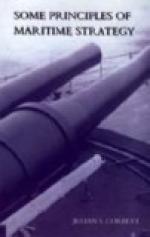The vice of the opposite method of procedure is obvious. If we assume the maxim that the first duty of our fleet is to seek out the enemy wherever he may be, it means in its nakedness that we merely conform to the enemy’s dispositions and movements. It is open to him to lead us wherever he likes. It was one of the fallacies that underlay all Napoleon’s naval combinations, that he believed that our hard-bitten admirals would behave in this guileless manner. But nothing was further from their cunning. There is a typical order of Cornwallis’s which serves well to mark their attitude. It was one he gave to Admiral Cotton, his second in command, in July 1804 on handing over to his charge the Western Squadron off Ushant: “If the French put to sea,” he says, “without any of your vessels seeing them, do not follow them, unless you are absolutely sure of the course they have taken. If you leave the entrance of the Channel without protection, the enemy might profit by it, and assist the invasion which threatens His Majesty’s dominions, the protection of which is your principal object.”
It is indeed a common belief that Nelson never permitted himself but a single purpose, the pursuit of the enemy’s fleet, and that, ignoring the caution which Cornwallis impressed upon Cotton, he fell into the simple trap. But it has to be noted that he never suffered himself to be led in pursuit of a fleet away from the position he had been charged to maintain, unless and until he had made that position secure behind him. His famous chase to the West Indies is the case which has led to most misconception on the point from an insufficient regard to the surrounding circumstances. Nelson did not pursue Villeneuve with the sole, or even the primary, object of bringing him to action. His dominant object was to save Jamaica from capture. If it had only been a question of getting contact, he would certainly have felt in a surer position by waiting for Villeneuve’s return off St. Vincent or closing in to the strategical centre off Ushant. Further, it must be observed that Nelson by his pursuit did not uncover what it was his duty to defend. The Mediterranean position was rendered quite secure before he ventured on his eccentric movement. Finally, we have the important fact that though the moral effect of Nelson’s implacable persistence and rapidity was of priceless value, it is impossible to show that as a mere strategical movement it had any influence on the course of the campaign. His appearance in the West Indies may have saved one or two small islands from ransom and a good deal of trade from capture. It may also have hastened Villeneuve’s return by a few days, but that was not to our advantage. Had he returned even a week later there would have been no need to raise the Rochefort blockade. Barham would have had enough ships at his command to preserve the whole of his blockades, as he had intended to do till the Curieux’s news of Villeneuve’s precipitate return forced his hand before he was ready.




